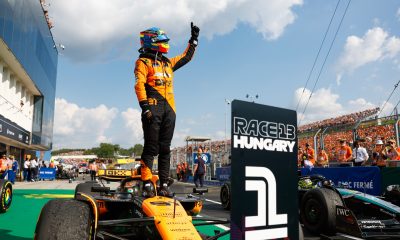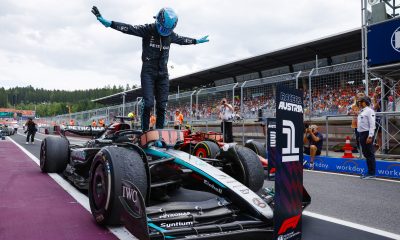
Max Verstappen of the Netherlands driving the (1) Oracle Red Bull Racing RB19 on track during the F1 Grand Prix of Great Britain at Silverstone Circuit on July 09, 2023 in Northampton, England. (Photo by Dan Mullan/Getty Images)
Netflix’s sensation documentary, “Formula 1: Drive To Survive“, is set to come back for a sixth season on Feb. 23, 2024, which purposely coincides with the third and final day of pre-season testing in Bahrain.
This new season will follow the drivers through the 2023 season. “Drive to Survive” has been an amazing success ever since it first premiered in 2018. So, what was the key of its great success?
The first episode of the series, called “All to Play For” introduces us to the former Red Bull driver, Daniel Ricciardo. The Netflix crew follows him around as he goes into the 2018 season, his fifth year at the Milton Keynes based team. His charisma and smile immediately stood out, catching the spectators’ attention. Some might even say he’s one of the reason of the documentary’s success, calling him the “main character” of DTS (Drive To Survive).
The good thing about DTS is that they follow many teams and drivers in a single episode, showing different perspectives. Haas is also introduced, an independent American team who are struggling. Güenther Steiner, the team principal, is another notable personality, his humorous and serious demeanor and constant cursing also getting much attention.
As the series goes on, you can see the pattern, where instead of showing a more professional side, they show the personal side. The drivers’ lives, struggles, personalities, and the passion they have — those are things that cannot be seen when watching a Grand Prix where you just see helmets and cars.
DTS aims to show the person under the helmet as well as the people behind the scenes of an F1 weekend.
An episode that stood out in particular was the eight episode of the first season, “The Next Generation“. This episode introduces audiences to Charles Leclerc, a Monegasque driver who dreams of driving for the most historical team in F1, Ferrari.
The episode starts showing the dangerous side of the sport, the part that most people forget about, the part where the drivers risk their lives every weekend. This leads to the introduction of Jules Bianchi, a former F1 driver who sadly lost his life in a horrible accident at the 2014 Suzuka Grand Prix.
Bianchi was also Leclerc’s godfather and was seen as a perfect candidate to drive for Ferrari before his passing.
“What Charles is doing is a continuation of Jules’ legacy,” Nicolas Todt narrated in DTS, “Charles has a mission…a mission to do what Jules should have done.”
This episode had a huge emotional impact on many. DTS explores this emotional path, making the spectator root for a driver as they get to know their life story, struggles, and the motives of what they do.

Charles Leclerc celebrates his second win of the 2022 Formula 1 World Championship season. (Photo: Ferrari)
James Gay-Rees, the producer of “Formula 1: Drive to Survive” reflected on the documentary’s success after the launch date of season six was confirmed publicly.
“Genuinely, we are enormously proud to be a part of it,” he said to Formula1.com. “There’s also a lot of satisfaction at being first with these things, and I think that it kind of does feel like the first main access show – certainly out of the UK anyway – that has had this profound effect.”
“We’ve all had the statistics about the changing, younger demographic, and it’s tough out there for anybody, for any big organisation, to hold its ground given the amount of choices that are out there for the consumer. Bringing such a big new audience to a sport – which obviously was deserved, it just needed somebody to open it up – is massively satisfying.
“The fact that it wasn’t a fluke, the fact that it’s grown [with every season]… It’s a real honour and we love it. It’s a very difficult show to make, but we love the process, we love the world. Long may it continue!”
DTS has given a huge exposure to the sport and this has been positive for some drivers but not so positive for others. A perfect example of this is the Red Bull driver, Max Verstappen.
Verstappen was antagonized to create drama, leading to people calling him ” The Villain of F1“, as he was portrayed as Ricciardo’s competition. They showed crashes between the teammates, glares, and interviews that made it seem like they disliked each other, which was far from reality. After such negative exposure, Verstappen refused to give further interviews to the Netflix crew. He decided not to participate again until the fifth season of the series.
“Of course, I understand when you create a show, there needs to be drama, it needs to be exciting. But I’m a guy who finds it also very important that you’re portrayed well, and that they do not start to copy comments on the different kinds of footage while it didn’t happen like that,” Verstappen said on the 2023 livery launch ahead of his return to the show, “I had to explain it to them that that was my view. Otherwise, I didn’t want to be part of it. But yes, they understood.”

Race winner Max Verstappen of the Netherlands and Oracle Red Bull Racing celebrates on the podium after the F1 Grand Prix of Mexico at Autodromo Hermanos Rodriguez on October 29, 2023 in Mexico City, Mexico. (Photo by Jared C. Tilton/Getty Images)
“Drive to Survive” forever changed the way F1 is viewed, bringing in a younger audience and sparking a love for Formula 1 in them. This, apart from bringing spectators, brings future generations of engineers, journalists, presenters, and maybe even potential drivers. DTS owes its success to its aim towards younger generations, its personal approach being a breath of fresh air for such a serious and risky sport.












